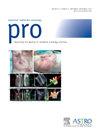Radiation Therapy for Heterotopic Ossification: A Systematic Review
IF 3.5
3区 医学
Q2 ONCOLOGY
引用次数: 0
Abstract
Purpose
Heterotopic ossification (HO) is a benign disorder characterized by ectopic bone formation in soft tissues that can lead to functional loss in patients. We conducted a systematic review of the evidence on the use of radiation therapy (RT) for the prevention or treatment of HO.
Methods and Materials
Literature searches were conducted using Medline (via PubMed), Embase, and ClinicalTrials.gov until April 1, 2023. Medical subject headings and free text terms relevant to HO and RT were used. In brief, eligible study participants were ≥18 years of age with HO and were treated with low-dose external RT. Two reviewers screened relevant abstracts and extracted full-text data for analysis. The review followed the Preferred Reporting Items for Systematic Review and Meta-Analysis guidelines.
Results
Ten studies evaluating the effect of RT for either the prevention or treatment of HO met the inclusion for evidence synthesis. Nine randomized controlled trials did not clearly report their methods and had a medium risk of bias. The studies were conducted between 1988 and 2008, with follow-up ranging on average from 3 to 59 months posttreatment. A total of 1530 participants were analyzed, and 566 were treated with RT following fracture fixation, total hip arthroplasty, or total hip replacement. In pooled data from 8 randomized controlled trials, there was a nonsignificant but clinically meaningful reduction in the presence of HO at follow-up for patients who received RT versus comparators (pooled odds ratio, 0.47; 95% CI, 0.19, 1.17). There was minimal evidence of adverse events.
Conclusions
This systematic review found a clinically, but not statistically, significant benefit of prophylactic RT for HO at follow-up. These findings are tempered by a moderate risk of bias. While practice patterns vary, RT for HO prophylaxis in high-risk patients may have benefits that outweigh the risks.
异位骨化的放射治疗:系统回顾
导言:异位骨化(HO)是一种良性疾病,其特点是软组织中的异位骨形成,可导致患者功能丧失。我们对使用放射治疗(RT)预防或治疗异位骨化的证据进行了系统性回顾:我们使用 Medline(通过 PubMed)、Embase 和 ClinicalTrials.gov 对截至 2023 年 4 月 1 日的文献进行了检索。使用了与 HO 和放射治疗相关的医学主题词(MeSH)和自由文本词。简而言之,符合条件的研究参与者年龄≥18岁,患有异位骨化并接受过低剂量体外 RT 治疗。两名审稿人选择了相关摘要并摘录了全文数据进行分析。综述遵循 PRISMA 指南:10项评估RT预防或治疗异位骨化效果的研究符合证据综合的要求。9项RCT研究未明确报告其研究方法,存在中等偏倚风险。这些研究在1988年至2008年间进行,平均随访时间从治疗后3个月到59个月不等。共分析了 1530 名参与者,其中 566 人在骨折固定、全髋关节置换术(THA)或全髋关节置换术(THR)后接受了 RT 治疗。汇总八项研究的数据后发现,接受RT治疗的患者在随访时出现异位骨化的几率比接受RT治疗的患者低(汇总OR = 0.47,95% CI [0.19,1.17]),虽然不显著,但却具有临床意义。不良事件的证据极少:本系统综述发现,预防性 RT 对随访的 HO 有临床显著疗效,但无统计学意义。这些研究结果存在一定的偏倚风险。虽然实践模式各不相同,但在高风险患者中预防性 RT 治疗 HO 的益处可能大于风险。
本文章由计算机程序翻译,如有差异,请以英文原文为准。
求助全文
约1分钟内获得全文
求助全文
来源期刊

Practical Radiation Oncology
Medicine-Radiology, Nuclear Medicine and Imaging
CiteScore
5.20
自引率
6.10%
发文量
177
审稿时长
34 days
期刊介绍:
The overarching mission of Practical Radiation Oncology is to improve the quality of radiation oncology practice. PRO''s purpose is to document the state of current practice, providing background for those in training and continuing education for practitioners, through discussion and illustration of new techniques, evaluation of current practices, and publication of case reports. PRO strives to provide its readers content that emphasizes knowledge "with a purpose." The content of PRO includes:
Original articles focusing on patient safety, quality measurement, or quality improvement initiatives
Original articles focusing on imaging, contouring, target delineation, simulation, treatment planning, immobilization, organ motion, and other practical issues
ASTRO guidelines, position papers, and consensus statements
Essays that highlight enriching personal experiences in caring for cancer patients and their families.
 求助内容:
求助内容: 应助结果提醒方式:
应助结果提醒方式:


